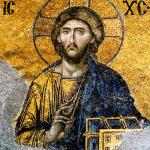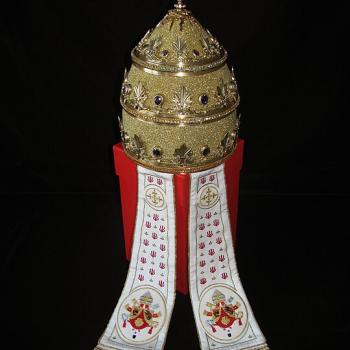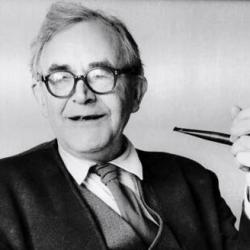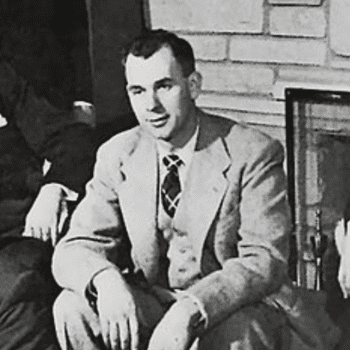One of the challenges of writing intellectual history is the task of summing up large works in a relatively small amount of space. Doing this for Karl Barth’s multivolume Church Dogmatics, proclaimed by many as “the most important theological work of the twentieth,” has proven especially daunting for me as I continue to work on a current book project. I include here my attempt to do so. Did I do justice to the work? Did I capture its general shape? What makes for a good summary? If any Barth readers care to weigh in, I am “all ears” to hear your criticism.
I begin in media res:
… Amid it all, Basel, Switzerland once referred to as “the sulking corner of Europe” by a nineteenth-century German nationalist historian, became arguably the epicenter of the Protestant theological world in the postwar era with people traveling from the world over to meet or study with someone whom many regarded as a living Church Father. They came to hear him lecture, to visit him in his office, attracted to his conception of theology, which [Karl] Barth, no doubt reflecting his own desires and anxieties, once memorably described as
the fairest [of the disciplines], the one that moves the head and heart most fully, the one that comes closest to human reality, the one that gives the clearest perspective on the truth, which every discipline seeks. It is a landscape like of those of Umbria and Tuscany with views which are distant yet clear, a work of art which is well planned and as bizarre as the cathedrals of Cologne and Milan. . . . But of all disciplines theology is also the most difficult and the most dangerous, the one in which a man is most likely to end in despair, or—and this is almost worse—in arrogance. Theology can float into thin air or turn to stone, and worst of all it can become a caricature of itself.
At some level, such loquacity bear witness to Barth’s foremost labor during the postwar years: his monumental Church Dogmatics. With volume one published in 1932 and still incomplete when Barth died in 1968, the multi-volume work is comprised of roughly 9,000 pages, twice as long as Aquinas’ Summa, and 15,000 biblical citations. Aptly nicknamed by Barth his “White Whale” or “Moby Dick,” the work defies simple description. But it merits keeping in mind that the text stemmed from lectures in Barth’s courses on dogmatics and that the majority of students present were young men training for pastoral ministry. Despite its theoretical flights and immense erudition, in other words, Church Dogmatics possesses an undeniable pastoral, practical quality. Written in an academic context, it is oddly not of this context, if deeply learned throughout. Quick with self-deprecating humor, Barth periodically joked that the “angels [must] laugh at old Karl. They laugh at him because he tries to grasp the truth about God in a book of Dogmatics. They laugh at the fact that volume follows volume and each is thicker than the previous one.” At best, Barth believed that the theologian should act only like John the Baptist in the crucifixion scene from Matthias Grünewald’s famous Isenheim Altarpiece, pointing his long, awkward bony finger at Jesus on the cross. (Barth kept a copy of this painting above his desk and relished explaining to visitors its significance for him.)
From the outset, Barth intended Church Dogmatics to encompass five principal parts or volumes, most with sub-volumes as well. In the first, “The Doctrine of the Word of God” (two volumes), Barth offers a general prolegomenon on the nature of theology and theological sources and methods, arguing that for Christians, theology does not study God in the abstract but a divine Revelation irreducibly Trinitarian in nature. Although theology resides within the university, it is there as “stopgap in a disordered cosmos.” It should not be bound by general concept or principle of science; “its task [rather] is . . . to criticize and revise language about God by the standard of the principle peculiar to the Church.” Hence, Church dogmatics. In part two, which is broken into two volumes, he discusses “The Doctrine of God,” while part three (four volumes) covers “The Doctrine of Creation.” In the former, emphasizing again the Trinity, Barth contends that God is at once “wholly other” and personally near, not comprehensible by human reason or any human philosophy, but freely made know through God’s Word, which the Christian submits to in faith. In the latter, Barth turns his focus to Creation as a divine act, as well as human sinfulness and evil—arrestingly conceptualized as “the nothingness” (das Nichtige)– as the willful ruination of this act. Throughout, he argues that Creation cannot be separated from God’s Redemption; a profound interconnectedness and simultaneity exists between the two doctrines; one cannot be wisely thought about without the other.
Part four (four volumes) is dedicated to “The Doctrine of Reconciliation.” Many critics judge this as Barth’s masterwork, even though it remained incomplete upon his death. “‘God with us,’” he boldly proclaims here, “[stands at] the core of the Christian message, the decisive general statement of the Christianity community.” “What unites God and us men,” he further elaborates, “is that He does not will to be God without us, that He creates us rather to share with us and therefore with our being and life and act His own incomparable being and life and act, that He does not allow His history to be His and ours ours, but causes them to take place as a common history. That is the special truth which the Christian message has to proclaim at is very heart.” A projected but never begun fifth part, “The Doctrine of Redemption,” was supposed to cover eschatological themes, including life after death and the Last Judgement. Throughout the Church Dogmatics, interspersed within the main text, are small-print sections that serve at once as footnotes, examinations of primary and secondary works, and places for excurses on particular points. For fellow theologians reading Barth, these are sometimes the juiciest bits even if some might come across as unconstrained pedantry.
Attempting to summarize the Church Dogmatics is of course be a fool’s errand. But it is noteworthy that on several occasions Barth himself sought to rise above the particulars and articulate the work’s principal concern. “In none of these fields [the principal parts mentioned above],” he wrote in an article for the Christian Century, “could I go along with accepted church doctrine and theological tradition. I had to think and develop everything anew, from a center which I considered the right one—namely, the Old and New Testament witness to the person and work of Jesus Christ. So year after year I found myself confronting new and exciting questions, and involved in problems to solve and connect for which I had to travel a long road.” The person of Jesus Christ pervades everything; Barth sometimes referred to John 1:14–“And the Word became flesh and lived among us, and we have seen his glory, the glory of a father’s only son, full or grace and truth” (NRSV)—as a decisive touchstone verse. Colossians 1: 15-17 also sheds light: “He [Christ] is s the image of the invisible God, the firstborn of all creation, for in him all things in heaven and on earth were created, things visible and invisible, whether thrones or dominions or rulers or powers—all things have been created through him and for him. He himself is before all things, and in him all things hold together” (NRSV). For this reason, Barth judged Hans Urs von Balthasar’s famous charge against him—that he was guilty of “Christological narrowness” or “Christomonism”—as an inadvertent compliment. (Incidentally, Barth attended several of Balthasar’s lectures—given in Basel and forming the first draft of what became The Theology of Karl Barth (1951)—eager, as he quipped, “to learn more about myself.”) The theologian Robert Jenson helpfully adds that the Church Dogmatics offers nothing less than a “Christocentric metaphysics,” “an encompassing, flexible, and drastically coherent Christological interpretation of all reality.” Barth’s allergic reaction to all “natural theology” is largely maintained throughout, insofar as Barth assiduously seeks to reason not from a particular philosophy or general notion of God toward Christian revelation. Rather, he reverses things, contending that God’s revelation in Jesus Christ, for the faithful theologian, is the given, necessary starting point from which everything else much be understood. Faith seeks understanding; understanding, by its own lights, cannot arrive at faith. In Barth’s uncompromising words: “the logic of the matter demands that, even if we only lend our little finger to natural theology, there necessarily follows the denial of God in Jesus Christ.” Rather: “The possibility of knowledge of God’s Word lies in God’s Word and nowhere else.” . . .
















